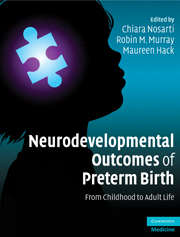Book contents
- Frontmatter
- Contents
- List of contributors
- Preface
- Section 1 Introduction
- Section 2 Neuroimaging
- Section 3 Behavioral outcome
- 9 Behavioral outcome of preterm birth in childhood and adolescence
- 10 Preterm birth and fetal growth in relation to adult psychopathology
- Section 4 Neuropsychological outcome
- Section 5 Applied research
- Section 6 Conclusions
- Index
10 - Preterm birth and fetal growth in relation to adult psychopathology
from Section 3 - Behavioral outcome
Published online by Cambridge University Press: 06 July 2010
- Frontmatter
- Contents
- List of contributors
- Preface
- Section 1 Introduction
- Section 2 Neuroimaging
- Section 3 Behavioral outcome
- 9 Behavioral outcome of preterm birth in childhood and adolescence
- 10 Preterm birth and fetal growth in relation to adult psychopathology
- Section 4 Neuropsychological outcome
- Section 5 Applied research
- Section 6 Conclusions
- Index
Summary
Intrauterine and neonatal factors seem to be important in the pathogenesis of childhood and adolescent psychiatric disorders like infantile autism, attention deficit hyperactivity disorder (ADHD), and anorexia nervosa, but also in psychiatric disorders which are not usually seen until late adolescence or adulthood, such as schizophrenia. Being born preterm, with a low birth weight or with indications of fetal growth retardation are among the most robust and replicated perinatal risk factors associated with psychiatric outcome. Additionally, preterm delivery is more common in mothers with schizophrenia, mothers with bipolar disorder, and among women with postpartum psychoses. No consensus has yet been reached concerning the interpretation of the association between preterm birth and psychopathology. In this chapter we report some of the findings and methodological challenges in the field.
Introduction
In studies of preterm birth as a risk factor for development of psychiatric disorders in adulthood, at least four research traditions and paradigms can be identified.
Firstly, during the last 30 years, the evolution of neonatal intensive care has encouraged extensive follow- up studies of very low birth weight (VLBW; < 1500 g) and very preterm infants, investigating developmental, behavioral, and neurological outcome in early childhood (reviewed in Chapters 3, 9, and 11). This has partly occurred due to an increase in survival of very preterm and VLBW babies, the introduction of new medical technology, and improvements in clinical neonatal intensive care (see also Chapters 1 and 2). Consequently, longer periods of follow-up have been facilitated, as has the investigation of diverse cognitive and behavioral deficits in late childhood and early adolescence.
- Type
- Chapter
- Information
- Neurodevelopmental Outcomes of Preterm BirthFrom Childhood to Adult Life, pp. 127 - 140Publisher: Cambridge University PressPrint publication year: 2010



